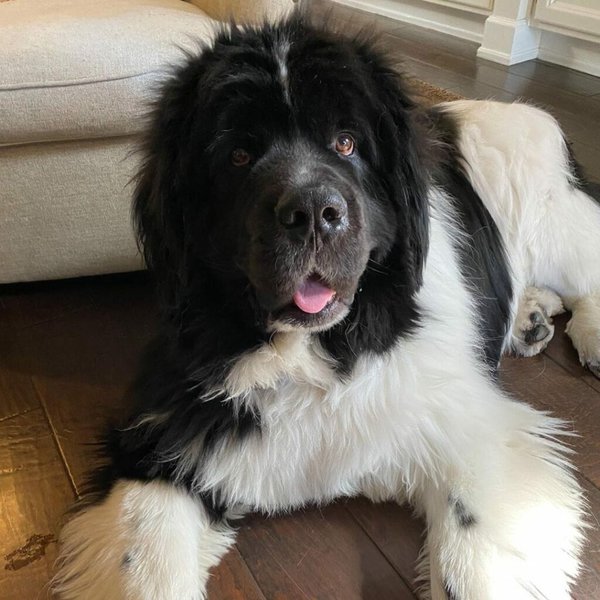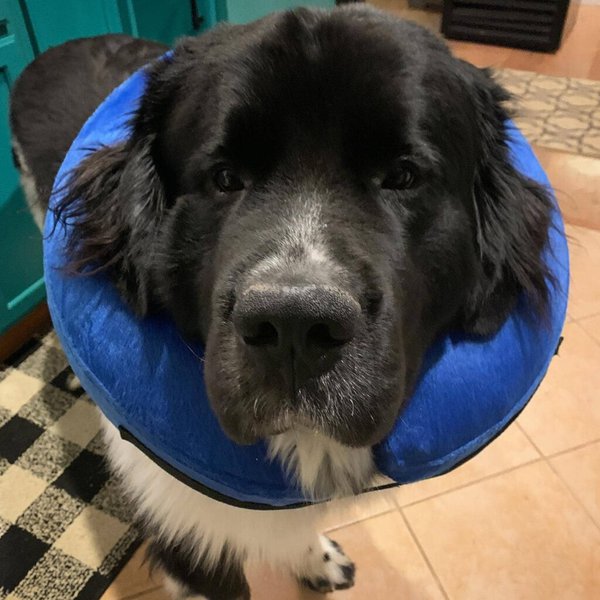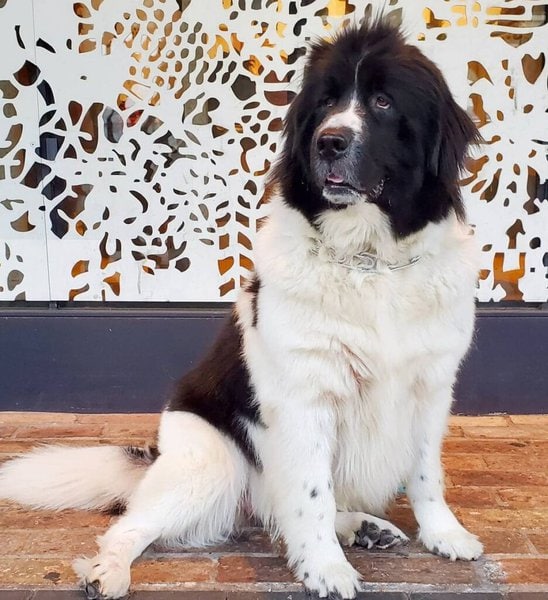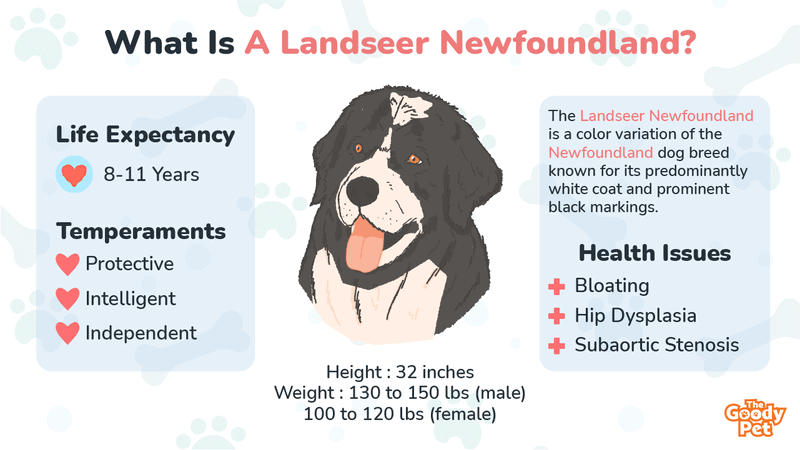The Newfoundland dog breed was ranked the 41st most popular dog breed in America in 2020 according to the American Kennel Club. The gentle giants are even more popular in the giant dog breed niche for their sweet personalities and unique aesthetics.
The Landseer Newfoundland dog is a color variation of the Newfoundland dog breed known for its predominantly white coat and prominent black markings. Contrary to popular misconception, the Landseer is not a separate breed from the Newfoundland dog breed.
If you are considering getting yourself a Landseer Newfoundland dog, there is a lot you need to know about the breed variation to best prepare yourself for your new giant fur baby. You have come to the right place for this. Let’s take a look at all you need to know about the so-called white Newfoundland dog or the Landseer. First off, let’s focus on their most distinguishing features.
What Is The Difference Between A Landseer And A Newfoundland?
The only difference between a Landseer and any other Newfoundland is the coat color and patterns.
In the sections below, we shall take a closer look at this distinguishing feature of Landseers as well as other important features you may need to know about if you are considering getting one of these doggies.
Here are 2 of the most important of these features.
Coat Color And Patterns
The Landseer Newfoundland has a predominantly white coat with usually black markings. However, there are some Landseers that are brown and white with white fur still covering most of the body.
With Landseer Newfoundlands, the distribution of the dark markings on the white coat is limited to the head with a few spots on the back and tail. In fact, some Landseers have a fully black or brown head.
The white coat is a result of the piebald gene. This gene is recessive which means that the Newfoundland parents need to both either be Landseers or carriers of the piebald gene to produce Landseer puppies. This is why Landseers are so rare.
Height And Weight
The Landseer Newfoundland is built the same as any other Newfoundland. However, Landseers that were exported to Europe are typically larger than their North American Counterparts.
How big a Landseer Newfoundland gets is generally determined by their genetics as well as their gender. In terms of weight, male Landseers range from 130 to 150 lbs while female Landseers range from 100 to 120 lbs.
When it comes to height, the Landseer Newfoundland can be as tall as 32 inches when fully matured.

How Long Do Landseer Newfoundlands Live?
Landseer Newfoundlands can live for 8 to 11 years. This is on the lower end of the scale for dogs and is mainly due to the Landseer’s large size.
Despite their relatively short lifespan, Landseer Newfoundland dogs are relatively healthy doggies. However, there are some common health issues that you need to be aware of and keep an eye out for, as such conditions put Landseer Newfoundland dogs at risk, including some of which they commonly die from.
Subaortic Stenosis
Subaortic stenosis (SAS) is a congenital heart disease that is very common in Newfoundlands including the Landseer variation. In simple terms, the condition causes the narrowing of the aorta and thus puts extra strain on the heart to pump against resistance.
While it can be a mild disease, severe narrowing could actually kill the Landseer. This is why it is so important to keep up with routine vet checkups for screening and early diagnosis.
Bloat
Bloat occurs when the Landseer’s stomach dilates and twists when they eat or drink too much, too fast. It is another common, life-threatening condition in Landseer Newfoundlands that requires urgent veterinary attention.
Hip And Elbow Dysplasia
Joint dysplasia is a condition where the joint socket forms abnormally resulting in instability. In Landseer Newfoundland dogs, the hip and elbow joints are the most commonly affected.
With time, hip and elbow dysplasia predisposes the Landseer to arthritis and mobility issues. However, this process can be slowed down and mitigated by moderate exercises, a healthy diet, and supplements like chondroitin and glucosamine.
Ear Infections
Ear infections are common among Landseers due to their long, hairy ears that create the perfect environment for germs to thrive. This is made worse by swimming in which case moisture gets trapped in the ears.
Fortunately, good grooming practices can help lower the Landseer’s risk of developing ear infections. For example, using a pair of scissors in trimming the excess hair whenever it is found protruding out of the ear canal of the Landseer.

How To Take Care Of Landseer Newfoundland Dogs?
The Landseer Newfoundland is a somewhat high-maintenance dog breed. This is largely due to its size and associated care needs. Their coat also needs some extra tender love and care to keep them looking beautiful.
For first-time Landseer owners, it is important to understand all these needs and come up with a care plan to raise a happy, healthy, and beautiful doggy. Here are a few tips that should come in handy.
Exercise Needs
Landseer Newfoundlands have the potential of being very lazy if they are allowed to get away with it. However, in order to avoid diseases like obesity as well as for the sake of mental engagement, you need to ensure that they live active lives.
Ideally, they should get between 30 minutes to 1 hour of exercise every day. This could be something like a walk, a hike, or more intense ball games and exercises.
Diet Needs
The Landseer Newfoundland dogs are large pooches with large appetites. They need about 4 to 5 cups of dry dog food every day.
It is important that the meals are balanced with protein and healthy fats making up most of the meal proportions. In addition to these, make sure to include micronutrients like vitamins and minerals for a truly all-rounded diet.
We recommend Pet Plate for high-quality dog food in portions and with recipes specially curated based on your Landseer Newfoundland dog’s needs.
Grooming Needs
Like any other dog, you need to ensure that your Landseer is regularly groomed for the sake of aesthetics as well as their own health and wellbeing. This will include regularly clipping their nails, wiping drool and tear tracks with doggy wipes, and cleaning their ears.
Not forgetting their dental needs, we recommend dental water additives that are convenient while still being effective at ensuring oral hygiene for your Landseer pooch.
Do Landseer Newfoundland Dogs Bark A Lot? Temperaments Of Landseer Newfoundland Dogs
As we mentioned earlier, the Landseer is not a separate breed from the Newfoundland. As a result, they share more or less the same temperament traits as any other color variation of the Newfoundland.
Like the Newfoundlands, the Landseers have mild barking tendencies. They only bark when there is a need to do so. However, there are a few differences here and there as well as extra quirks from the different historical uses of the Landseer that make them different.
Here is a summary of all these personality traits that you may pick up on with your Landseer Newfoundland dog.
Protective
Landseer Newfoundlands are very protective dogs. This is largely due to the fact that they served as working dogs in different positions including water rescue dogs and even personal defense dogs.
With a bit of training, your Landseer will make for a pretty decent guard dog.
Intelligent
Landseers are pretty smart dogs and actually considered among the top 50 most intelligent dogs, according to dog psychology expert Stanley Coren. They are particularly easy to train as they are very obedient and eager to please in addition to being smart.
Independent
If you want a dog that is content with its own company and to put up with your busy schedule, the Landseer is the ideal dog for you. The calm and independent Landseer Newfoundland can easily be left alone for hours without suffering psychological distress.
Patient And Gentle
Landseer Newfoundlands may be large and somewhat intimidating but they are the gentlest of creatures you will ever meet. They get along particularly well with children and even with other dogs and smaller pets, especially when they have undergone early socialization training.

Do Landseer Newfoundland Dogs Shed? Grooming Tips For Landseer Newfoundland Dogs
The Landseer Newfoundland dog has a beautiful and thick double coat. They shed moderately throughout the year but have 2 seasons of heavy undercoat blowouts during fall and spring seasons.
For the most part, the Landseer has the same grooming needs as any other Newfoundland as they all have the same coat type. However, the predominantly white coat on a Landseer may need a few tweaks to the grooming plan to keep them looking clean, bright, and beautiful.
Here are 2 of the most important grooming tips you need to know to keep your Landseer Newfoundland’s coat looking amazing.
Brush Your Landseer’s Coat 3 Times A Week
Regular brushing helps to get rid of the loose fur in your Landseer’s coat. Brushing also helps to detangle their long fur and prevent matting that negatively impacts the coat’s health in the long run.
In addition to regular brushing, you have to ensure that you invest in the right grooming tools for your Landseer Newfoundland’s thick, and long coat.
We recommend the FURminator Undercoat Tool whose thick bristles are more than up to the task of working through the Landseer’s dense double coat to get as much of the loose fur as possible.
Wash Your Landseer Every 2 Months
One of the best things about the Landseer’s coat is the fact that it is water-resistant. It is also very unlikely to get stained despite being mainly white.
As a result, you can get away with a long washing interval of as much as 2 months. This long interval also minimizes the risk of stripping the coat of protective oils from over-washing.
What you cannot afford to compromise on is the choice of washing products you use. The Seamus Cherry Blossom Whitening Dog Shampoo is ideal for the job with its whitening formula being exactly what you need to keep your Landseer’s white and black coat brilliant and beautiful.
Related Questions
How Much Does A Landseer Newfoundland Cost? A Landseer Newfoundland puppy costs between $2,000 and $2,500 on average. This is the same range you can expect for any other color variation of the Newfoundland dog breed. In addition to this initial expense, you should budget about $1,000 to $2,000 every year for care costs including the dog’s food, vet care, and grooming needs.
Can Landseer Newfoundlands Swim? Landseer Newfoundland dogs are not only good at swimming but are also pretty much built for the water. These large doggies are instinctively comfortable in water which probably has to do with their historic use as a water rescue dog. Landseer Newfoundlands also have water-resistant coats which make swimming more comfortable for them.
What Colors Are Newfoundlands? Newfoundland dogs come in a variety of colors including solid brown, solid black, or gray. They may also have two-tone coats in which case the black and white or brown and white Newfoundlands are the most common. The colors highlighted above are the only variations of the Newfoundland dog breed according to the American Kennel Club’s breed standards.





